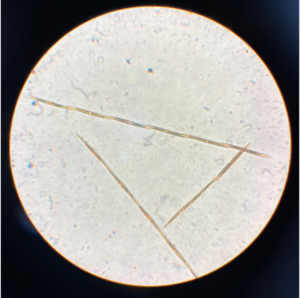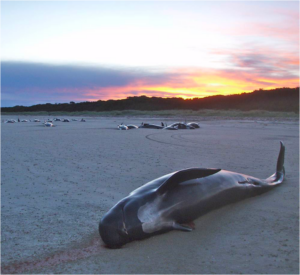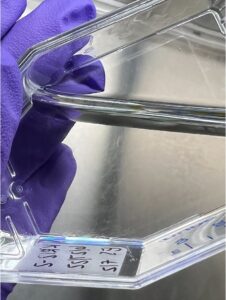Each summer, the University of Rhode Island Graduate School of Oceanography (GSO) hosts undergraduate students from all over the country to participate in oceanographic research. These Summer Undergraduate Research Fellows (SURFOs) have not only been working with GSO scientists, but they also have spent part of their time learning how to communicate this science to the public. Read on to find out what they have been up to, and why everyone should be as excited as they are about their work.
Elisabeth Sellinger is entering her senior year at the University of Colorado at Boulder in the Fall of 2022. She is majoring in Ecology and Evolutionary Biology and minoring in Atmospheric and Oceanic Sciences. Dr. Bethany Jenkins is her SURFO (Summer Undergraduate Research Fellowship in Oceanography) advisor and Bryan Plankenhorn is her SURFO mentor.
Let’s talk seafood poisoning…
Nothing is worse than a bad bout of seafood poisoning. The sickness can last for days and the mere thought of a bowl of clam chowder is enough to make you queasy. Now let’s throw another wrench into the mix– shellfish poisoning can now also be served with a side of short-term memory loss. It’s not all doom and gloom though, scientists are working to uncover why this is becoming an increasingly common issue, and how to better predict the conditions that produce toxic shellfish. This summer, research was done exploring these specific aspects of shellfish poisoning in Narragansett Bay, Rhode Island as recent closure events have spurred concern among local shellfisheries and public health officials alike.
Research Origins:
In 1987 on Prince Edward Island (PEI), Canada, an alarming number of people came down with symptoms including nausea, vomiting, headaches, and fever. Some cases were so severe they resulted in death. With a bit of investigation, the source of the disease was traced back to PEI mussels containing a high amount of a neurotoxin called domoic acid. Since this event, research has begun looking into the sources and conditions which produce domoic acid.

Diatom Breakdown:
Pseudo-nitzschia is a type of microscopic phytoplankton called diatoms. Some of these diatoms are responsible for the large amount of domoic acid produced in the oceans.
These tiny organisms make up a large percentage of the base of the food web, and are a common food source for larger plankton, which are then eaten by fish and so on. The energy provided by the diatoms travels up the food chain, along with the toxins they contain. This is what we call biomagnification. The top predatory species experience the greatest negative impact with the most concentrated amounts of toxins. Some of the species most at risk include whales and sea lions. Domoic acid can damage their spatial memory making it difficult to relocate breeding grounds or perform annual migrations. This results in hundreds of whales being found stranded on the shore.

How does this affect Rhode Island?
It turns out there are quite a few toxigenic species of Pseudo-nitzschia in Narragansett Bay. Levels of domoic acid in shellfish became so high that a precautionary bay closure was required in 2016, followed by a complete closure in 2017 to prevent disease outbreaks.
Since the 2016-2017 closure, the Jenkins laboratory group at the University of Rhode Island’s Graduate School of Oceanography has been taking weekly samples across Narragansett bay to track multiple elements of these diatoms. During bloom events, DNA was extracted from the weekly samples to identify what species were present. Tests were then run to determine how much domoic acid was being produced by Pseudo-nitzschia at each sampling time. Also during bloom events, monocultures, a single type of species grown in a lab setting, were produced in the lab so experimental manipulations could be run.

My Project:
This summer, I participated in the Summer Undergraduate Research Fellowship in Oceanography (SURFO) program. During my time in the SURFO program, I investigated how the cell growth and domoic acid production of one species of Pseudo-nitzschia isolated from Narragansett Bay, P. multiseries, was affected under three different types of nutrient conditions. In my experiment this summer, the ratios at which three different nutrients, nitrate (NO3), phosphate (PO4), and silicate (SiO3) were lowered compared to a control group. The control group used to culture the species P. multiseries was derived from previous studies that have found the ideal ratios of nutrients for promoting cell growth, better known as the Redfield Ratio.
It was found that while lower nutrient availability limited the growth of P. multiseries, the amount of domoic acid produced per cell increased significantly. This data is consistent with previous research performed on other Pseudo-nitzschia species. With this information, the scale and level of toxicity of Pseudo-nitzschia blooms based on water nutrient levels in Narragansett Bay can be better predicted. Public health officials and local shellfisheries in Rhode Island will be more thoroughly informed of these domoic acid-inducing conditions in order to prevent disease outbreaks. Now the next time you’re chowing down on a good lobster roll, you can rest assured knowing scientists are hard at work to make certain you are consuming safe seafood!
Sources:
Bates, Stephen S, et al. “Bloom Dynamics and Physiology of Domoic-Acid- Producing Pseudonitzschia Species.” Marine Ecology Progress Series, vol. 100, 1998, pp. 267–292., https://doi.org/10.3354/meps100185.
Oregon State University. (2008). Pilot Whale Strandings. Retrieved August 2, 2022, from
https://creativecommons.org/licenses/by-sa/2.0/?ref=openverse.
Sterling, Alexa R., et al. “Emerging Harmful Algal Blooms Caused by Distinct Seasonal Assemblages of the Toxic Diatom Pseudo-Nitzschia in Narragansett Bay, RI, USA.” BioRxiv, 19 Aug. 2021, https://doi.org/10.1101/2021.08.18.456122.
I am a PhD candidate at the University of Connecticut-Avery Point exploring the dynamic interactions of microplastics and suspension feeding invertebrates. Through both field and laboratory work, I am working to understand which kinds of microplastics (different shapes, sizes, compositions) oysters, mussels, tunicates, and slippersnails consume and determine which species can be used to monitor microplastic pollution in our coastal waters. When I am not working on my research, I enjoy hiking with my husband and pup, being near or in the water, and spending time with family and friends.

